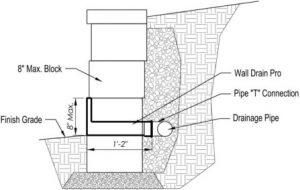Retaining Walls are an excellent way to protect your yard from water and erosion damage. The one issue is that they can be costly to install. A Retaining Wall System will fill in the gaps around your base and add additional footers to the wall. This will considerably improve your home’s resale value and curb appeal when prolonging the life span of your walls.
Retaining Walls Drainage

Retaining Walls come in many different materials like rock, clay or concrete. There are many distinct styles and options for Retaining Walls. Some of the most typical Retaining Walls are tangible footers, brick walls, stone walls, asphalt and vinyl. Vinyl Retaining Walls is relatively new in the marketplace but has become very common.
Retaining Walls Drainage
Vinyl Retaining Walls have been in existence for a long time but are just getting more popular in the past couple of years. This material comes in rolls very similar to carpet. The very best thing about vinyl is that it does not retain moisture like lots of other Retaining Walls. Also, they do not absorb water such as concrete footers. Vinyl is much easier to clean than concrete retaining walls.
Retaining Walls Drainage
It’s important to note there are many differences in the substance when it has to do with Retaining Walls. Stone Retaining Walls and bricks are just two of the most common. They are both beautiful and durable. Stone Retaining Walls can be purchased ready-made or you may opt to construct your own. Brick is also a beautiful option and may be customized with interesting patterns.
- There are a range of other options available to you in case you’d prefer a brand new Retaining Wall system for your home. One new option that is gaining popularity is a New River Rim Stone System. These unique stones can be used anywhere you like, such as your own landscaping. The New River Rim Stone System comes in a wide array of colours and patterns. It’s very simple to personalize these stones which make them one of a kind. This brand new system for keeping walls allows you to enjoy the beauty of the outdoors in your favourite outdoor area.
Retaining walls are usually built adjacent to a house. When constructing a Retaining Wall, you should first figure out the quantity of space you will need to cover. If the area is small, you might need to construct a lower wall. You may add on to the present Retaining Wall or place new walls across the lower wall.
Retaining walls are also a great way to conceal the clutter that accumulates in your yard. By building retaining walls, you can direct the traffic away from your house and lawn. Additionally, the walls will also greatly increase the marketability of your house.
Retaining walls are also a superb investment. Not only will they enhance the appearance of your home by obstructing views, they will also provide protection. Retaining walls will save you money on landscaping repair, roof maintenance, and utility hookups. The walls will also keep out deer and other animals which may destroy your plants and gardens.
Building Retaining Walls should be going on a parcel of property where the terrain is flat and level. These walls should be constructed with heavy-duty plywood, lumber, rebar, concrete or piers. The walls must be buried two feet into the ground to assist with drainage. Retaining walls must slope towards the house at forty-five levels. A broken piece of concrete will create a sloping hazard that may endanger motorists.
It is often quite expensive to install Retaining Walls on new properties. The cost depends on the material used, the dimensions of these retaining walls, and if they are made on a slope or not. Materials such as concrete, stone or flagstone are more costly to install than asphalt shingles. Additionally, it may take longer to set up Retaining Walls if they are built on sloping land.
The cheapest Retaining Wall substance is wood. The advantage of using wood is they require very little maintenance once they’ve been installed. Wood can also be weather resistant and these benefits make them the ideal material to use when installing Retaining Walls. Wood is also among the simplest materials to work with when it comes to building Retaining Walls.
Most homeowners employ an architect or engineer to design the Retaining Walls on their behalf. The cost of Designing and Fabricating Retaining Walls is generally involving seventy-four million dollars to one hundred forty thousand dollars. The actual prices will vary based upon the design and size of the Retaining Walls. Regardless of the price, the ultimate aim is to improve the landscape and make the home safer and more comfortable.
